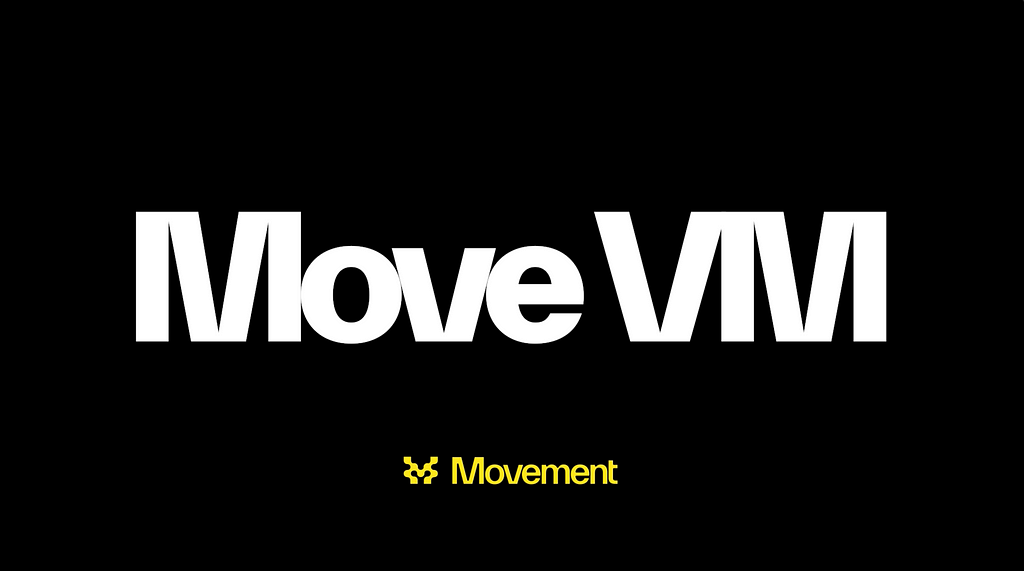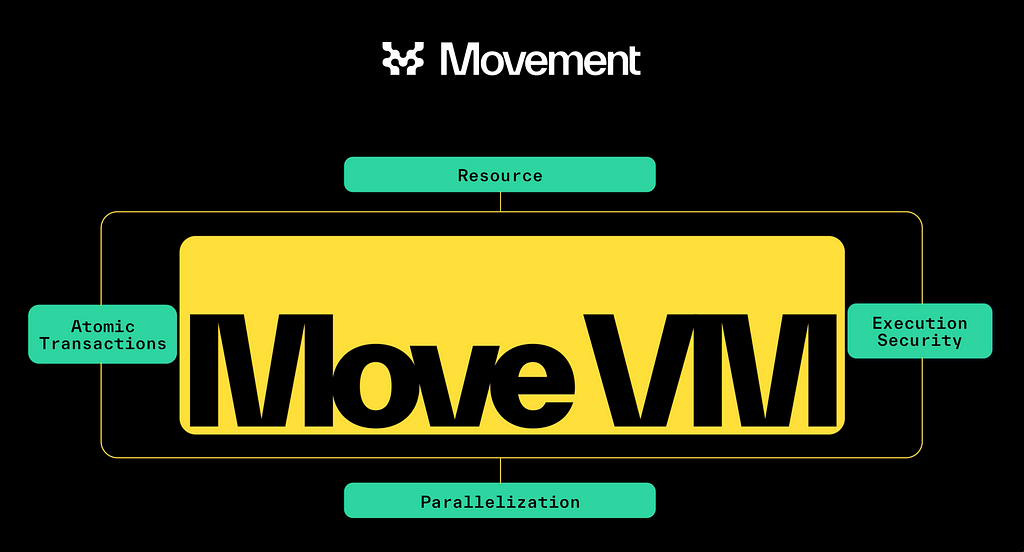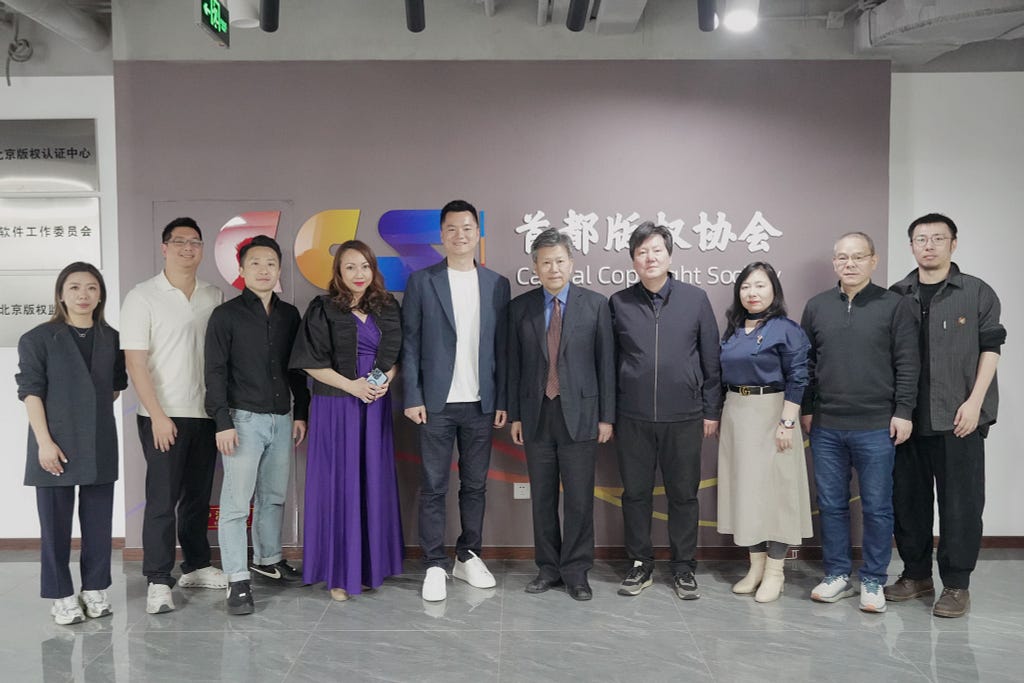The MoveVM: A New Era of Blockchain Precision and Safety

In the dynamic realm of blockchain technology, MoveVM emerges as a groundbreaking force, especially in conjunction with Movement Labs’ innovative strategies. This narrative explores how MoveVM, with its unique features and strategic integration into the Ethereum ecosystem through Movement Labs, is setting new standards in blockchain security, efficiency, and interoperability.
Introducing MoveVM: A New Era of Blockchain Precision
At the core of this technological leap is MoveVM, a state-of-the-art blockchain virtual machine that capitalizes on the Move programming language. This language’s resource-oriented programming paradigm treats digital assets as unique entities, fundamentally enhancing transactional integrity and preventing duplication. MoveVM’s inception marks a significant shift towards a blockchain infrastructure that is not only secure but also inherently organized and efficient.
MoveVM vs. EVM: A Comparative Analysis
In the landscape of blockchain technology, the contrast between MoveVM and the Ethereum Virtual Machine (EVM) is stark, highlighting a pivotal shift in how blockchain ecosystems can be designed for enhanced security and efficiency. Ethereum’s introduction of smart contracts was revolutionary, propelling blockchain into myriad applications beyond simple transactions. However, this innovation brought to light several challenges, notably in security and resource management.
Unpacking MoveVM’s Technological Superiority
In the landscape of blockchain innovation, MoveVM distinguishes itself through its advanced technological framework. At the heart of this framework lies MoveVM’s resource-oriented architecture (ROA), which revolutionizes asset management by treating digital assets as unique, indivisible entities. This approach ensures unmatched asset integrity and sets a new standard in the blockchain domain, challenging the conventional models and providing a more secure and logical structure for asset handling.

The security ethos of MoveVM is further embodied in its bytecode verification process, a rigorous mechanism that scrutinizes executable code to ensure it meets stringent safety and correctness standards. This process not only prevents the execution of potentially harmful or flawed scripts but also reinforces the trustworthiness of the entire blockchain ecosystem. Through this meticulous verification, MoveVM establishes a robust defense against vulnerabilities, ensuring a secure and stable environment for blockchain operations.
These foundational aspects of MoveVM’s design lay the groundwork for its more nuanced functionalities, such as the Transaction-as-Script Model and the BlockSTM system. These features contribute significantly to the platform’s operational efficiency and scalability, showcasing MoveVM’s ability to innovate and enhance the blockchain experience. Moreover, the integration of formal verification within MoveVM not only fortifies its security landscape but also exemplifies its commitment to providing a reliable and advanced blockchain solution. This sets the stage for an in-depth exploration of MoveVM’s unique capabilities, highlighting its potential to redefine blockchain technology with a focus on security, efficiency, and resource management.
Resource-Oriented Architecture: Redefining Blockchain Asset Management
MoveVM introduces a groundbreaking shift in blockchain technology with its resource-oriented architecture (ROA), fundamentally differentiating it from Ethereum’s account-based model. This architecture is at the core of MoveVM’s superiority, providing a novel approach to handling digital assets that ensures unparalleled security, scarcity, and integrity.
In traditional blockchain systems like Ethereum, assets are typically represented as balances within accounts, similar to the way fiat currencies are stored in bank accounts. This model, while functional, presents certain risks and limitations, especially in terms of asset duplication and tracking. Ethereum addresses these issues through complex smart contract logic and stringent programming controls, but the inherent risk of unintentional asset replication or loss due to smart contract vulnerabilities remains.
MoveVM’s ROA, however, conceptualizes digital assets as unique, indivisible entities that exist within their own right on the blockchain. This means that assets are not merely numbers in an account but are treated as tangible resources with defined behaviors and constraints. Such a design ensures that these assets can be transferred, used, or transformed, but never duplicated or unintentionally destroyed, mirroring the conservation principles seen in physical asset management.
This architecture not only enhances the security and integrity of the blockchain but also aligns with real-world asset management practices, where the uniqueness and preservation of resources are paramount. By preventing the duplication and unauthorized manipulation of assets, MoveVM’s ROA drastically reduces the risk of fraud and errors, setting a new standard for asset safety in the blockchain space.
Moreover, the ROA facilitates more intuitive and secure smart contract development. Developers working with MoveVM can create contracts that inherently respect the unique, non-fungible nature of assets, reducing the complexity and potential for errors in smart contract code. This leads to more reliable, transparent, and manageable blockchain applications, further distinguishing MoveVM from Ethereum’s approach.
In conclusion, the resource-oriented architecture of MoveVM represents a significant advancement in blockchain technology, offering a more secure, efficient, and logical framework for asset management. This architecture not only addresses the limitations and risks associated with traditional blockchain models but also paves the way for innovative applications that leverage the intrinsic properties of digital assets.
Bytecode Verification: Elevating Blockchain Security
MoveVM’s approach to security is exemplified by its bytecode verification process, setting it apart from Ethereum’s execution model. Bytecode verification in MoveVM is a comprehensive safety mechanism that scrutinizes the executable code before it’s allowed to run on the blockchain, ensuring that it adheres to strict security and correctness standards.
In Ethereum, smart contracts are compiled into bytecode and deployed on the EVM without a mandatory pre-execution verification step. This model relies on the developers and auditors to ensure the code’s security, making it susceptible to vulnerabilities and attacks if not thoroughly vetted. While Ethereum has robust development tools and community-driven security practices, the inherent risk of deploying flawed or malicious code persists, as seen in various high-profile smart contract breaches.
Contrastingly, MoveVM implements bytecode verification as a core part of its execution process. Before any code is executed on the MoveVM, it undergoes a rigorous verification procedure that checks for safety, resource integrity, and adherence to the specified logic. This process includes type checking, resource usage analysis, and ensuring that the code does not violate the blockchain’s operational rules. By systematically analyzing the bytecode for potential security issues, MoveVM significantly reduces the risk of vulnerabilities and malicious activities on the blockchain.
This verification process not only enhances the security of the blockchain but also instills confidence among developers and users. Developers can rely on MoveVM’s robust verification framework to catch potential issues early in the development cycle, reducing the risk and cost associated with post-deployment fixes and audits. Users, on the other hand, benefit from a more secure and reliable blockchain environment, knowing that the smart contracts they interact with have been thoroughly vetted against a comprehensive set of security criteria.
Furthermore, MoveVM’s bytecode verification supports the platform’s resource-oriented architecture by ensuring that the assets and their associated operations comply with the defined rules, maintaining the system’s integrity and the assets’ uniqueness. This tight integration of security mechanisms with the core architectural principles of MoveVM creates a cohesive and robust blockchain ecosystem.
In summary, bytecode verification in MoveVM is a critical feature that significantly enhances the platform’s security landscape. By preemptively identifying and addressing potential issues before code execution, MoveVM offers a more secure, reliable, and trustworthy environment for deploying and executing smart contracts, marking a significant evolution in blockchain technology.
Transaction-as-Script Model
MoveVM’s Transaction-as-Script Model is a pioneering feature that differentiates it from traditional blockchain platforms like Ethereum. This model allows for scripts to be embedded directly within transactions, enabling them to be executed once and then discarded. This innovative approach not only enhances the flexibility and control of transaction execution but also optimizes blockchain efficiency.
In typical blockchain systems, transactions and the code that governs their behavior (smart contracts) are distinct entities. Smart contracts reside on the blockchain persistently, leading to increased storage requirements and potential performance bottlenecks. However, MoveVM’s approach, where the transaction logic is executed as an embedded script, means that the code is executed on-the-fly and does not need to be stored permanently on the blockchain.
This method significantly reduces the storage overhead on the blockchain, as the script exists only for the duration of the transaction execution. It streamlines the processing of transactions, as each transaction carries with it the specific logic needed for its execution, negating the need to reference separate stored contracts. This leads to a cleaner, more efficient blockchain state, with less bloat and faster transaction processing.
Moreover, the Transaction-as-Script Model in MoveVM allows for more granular and precise control over transactions. Developers can tailor the execution logic of each transaction to its specific requirements, enhancing the system’s overall flexibility and responsiveness. This fine-grained control mechanism ensures that transactions are not only more efficient but also more secure, as the scope of each transaction is tightly defined and controlled.
In essence, the Transaction-as-Script Model in MoveVM represents a significant leap forward in blockchain transaction processing, offering a more streamlined, efficient, and adaptable framework compared to traditional models. This innovation underscores MoveVM’s commitment to advancing blockchain technology and improving the overall user and developer experience.
BlockSTM: Harnessing Parallel Execution for Superior Throughput
BlockSTM revolutionizes MoveVM’s processing capabilities through its advanced parallel execution technology, markedly increasing transaction speeds by 17 to 20 times compared to traditional serial processing. This innovative approach enables the simultaneous handling of multiple transactions, drastically boosting the network’s throughput.
At the heart of BlockSTM’s efficiency is its ability to execute several transactions in parallel, diverging from the sequential processing common in platforms like Ethereum’s EVM. This parallelization optimizes computational resource utilization, allowing for rapid completion of numerous transactions concurrently and significantly improving system throughput.
The implementation of parallel execution in BlockSTM addresses critical scalability and performance bottlenecks faced by conventional blockchain systems. By allowing a multitude of transactions to be processed at once, BlockSTM eliminates potential delays and enhances the blockchain’s ability to manage large transaction volumes efficiently.
This feature is particularly crucial for supporting complex, high-frequency operations on the blockchain, making MoveVM an ideal platform for applications requiring robust and speedy transaction processing. The integration of BlockSTM into MoveVM not only exemplifies a leap in blockchain technology but also underscores a commitment to scalable, high-performance blockchain solutions.
In conclusion, BlockSTM’s parallel execution engine is a pivotal development for MoveVM, setting new benchmarks in blockchain transaction speed and network throughput. Its ability to process transactions concurrently represents a significant stride towards achieving scalability and efficiency in the blockchain domain.
Formal Verification in MoveVM: Setting the Security Standard
MoveVM’s formal verification process is a cornerstone of its security framework, establishing it as a leader in blockchain safety. By mathematically proving the correctness of smart contracts before execution, MoveVM ensures a level of security and reliability that is rare in blockchain platforms. This rigorous approach not only checks for errors and vulnerabilities but also certifies the logical soundness of the contract’s operations, guaranteeing that they behave as intended under all circumstances.
In contrast to the Ethereum Virtual Machine’s (EVM) method of reactive testing and auditing, MoveVM’s formal verification takes a proactive stance in security. This preemptive scrutiny means potential issues are identified and rectified before the smart contracts are ever executed on the blockchain, significantly minimizing the risk of exploitation and attacks. This forward-looking approach to security is a testament to MoveVM’s commitment to building a trustworthy and stable blockchain environment.
MoveVM’s formal verification represents a paradigm shift in how blockchain security is approached, moving from a model of detecting and fixing vulnerabilities post-deployment to one where security is integral to the development process. This shift not only enhances the security profile of the blockchain but also streamlines the development lifecycle by reducing the time and resources spent on post-deployment fixes and audits.
Moreover, the integration of formal verification within MoveVM aligns with its resource-oriented architecture, reinforcing the platform’s overall integrity and reliability. By ensuring that smart contracts are free from errors before they interact with digital assets, MoveVM provides a safe and controlled environment for executing complex blockchain operations.
Through formal verification, MoveVM not only addresses the inherent security challenges of blockchain technology but also sets a new standard for what developers and users can expect in terms of safety and reliability in the blockchain space. This commitment to high-level security through formal verification is what positions MoveVM as a stronghold of security in the ever-evolving world of web3.
Bridging Worlds
The integration of MoveVM with Ethereum represents a significant technical and conceptual challenge, centered on harmonizing MoveVM’s resource-centric, secure architecture with Ethereum’s flexible, developer-focused ecosystem. This integration requires careful consideration to maintain the inherent security and efficiency of MoveVM while adapting to the dynamic and broad-reaching environment of Ethereum.
The primary challenge lies in the fundamental differences between the two platforms: MoveVM’s strict resource management and security protocols versus Ethereum’s open and somewhat less restrictive development framework. Achieving seamless integration demands innovative solutions to reconcile these disparities without compromising the unique strengths of each system.
Integration Opportunity: Uniting Strengths
However, this challenge is also an opportunity to create a blockchain ecosystem that leverages the best of both worlds. Integrating MoveVM’s advanced security features and formal verification processes with Ethereum’s extensive developer network and liquidity can result in a more efficient, and scalable blockchain platform.
The potential benefits of this integration are vast, offering enhanced security and performance for Ethereum’s applications while providing MoveVM with a broader adoption landscape. This synergy can lead to the development of new blockchain solutions that are not only innovative but also more reliable and user-friendly, pushing the boundaries of current blockchain capabilities.
The successful fusion of MoveVM and Ethereum could set a precedent for future blockchain integrations, showcasing the possibilities of combining different blockchain architectures to achieve superior functionality, security, and user experience in the decentralized world.
Fusing MoveVM and Ethereum: A Synergistic Integration with M2 and Movement SDK
The fusion of MoveVM and Ethereum, orchestrated through the M2 framework and Movement SDK, marks a significant evolution in blockchain technology. Central to this integration is the Fractal system, adept at translating Solidity’s smart contracts into bytecode that is compatible with MoveVM, thus ensuring seamless operation across these distinct blockchain environments. This process not only maintains the intricate logic of Ethereum’s contracts but also harnesses MoveVM’s stringent security measures and resource-oriented programming capabilities.
Fractal acts as a crucial link, merging the flexibility and widespread adoption of Ethereum with the security-first approach of MoveVM. This confluence brings forth a unified blockchain ecosystem where the proven development ecosystem of Ethereum benefits from MoveVM’s enhanced security protocols, including its advanced formal verification processes and resource-centric model. Such integration is pivotal for advancing blockchain interoperability, offering developers a broader toolkit and more robust infrastructure for building decentralized applications.
Moreover, the integration is significantly bolstered by incorporating Zero Knowledge (ZK) proofs, elevating the security and efficiency of transactions. ZK proofs within the MoveVM framework add an extra layer of security and scalability, allowing for the verification of transactions without revealing underlying data. This addition is instrumental in creating a more secure and efficient platform, setting new interoperability standards within the blockchain community.
The collaboration between MoveVM and Ethereum, facilitated by the technological prowess of M2 and Movement SDK, does more than just merge two blockchain platforms. It creates a robust, scalable, and secure environment that is primed for the future of decentralized applications. This strategic union not only solves existing issues of scalability and security but also lays down a progressive path for the blockchain sector, encouraging innovation and adoption across diverse blockchain applications and ecosystems.
Conclusion: Envisioning a Unified Blockchain Future
In the evolving landscape of blockchain, MoveVM emerges as a transformative force, especially when integrated with Ethereum, facilitated by the innovative strides of Movement Labs. This integration represents a paradigm shift, merging MoveVM’s robust security and efficient programming model with Ethereum’s extensive ecosystem. The collaboration, driven by the M2 framework and Movement SDK, signifies a new era in blockchain technology, blending advanced security, efficiency, and interoperability to create a more efficient and scalable blockchain infrastructure.
Through the strategic union of MoveVM and Ethereum, enhanced by the Fractal system’s seamless code translation and the scalability of Zero Knowledge proofs, a synergistic environment is forged. This not only elevates the technological capabilities of both platforms but also sets a precedent for future blockchain innovations. It promises a unified blockchain future where the integrated strengths of MoveVM and Ethereum catalyze the development of sophisticated, secure, and user-centric blockchain applications, heralding a new chapter in the digital economy’s evolution.
The MoveVM: A New Era of Blockchain Precision and Safety was originally published in Movement on Medium, where people are continuing the conversation by highlighting and responding to this story.

